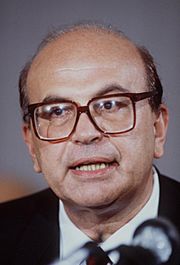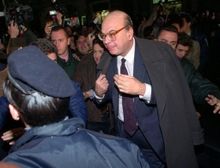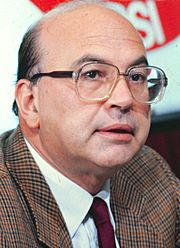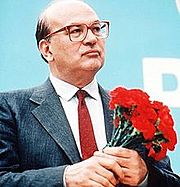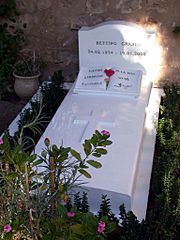Bettino Craxi facts for kids
Quick facts for kids
Bettino Craxi
|
|||||||||||||||||||||
|---|---|---|---|---|---|---|---|---|---|---|---|---|---|---|---|---|---|---|---|---|---|
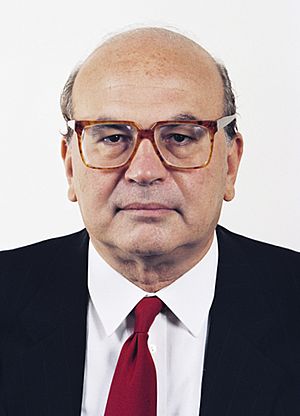 |
|||||||||||||||||||||
| Prime Minister of Italy | |||||||||||||||||||||
| In office 4 August 1983 – 18 April 1987 |
|||||||||||||||||||||
| President | Sandro Pertini Francesco Cossiga |
||||||||||||||||||||
| Deputy | Arnaldo Forlani | ||||||||||||||||||||
| Preceded by | Amintore Fanfani | ||||||||||||||||||||
| Succeeded by | Amintore Fanfani | ||||||||||||||||||||
| Secretary of the Italian Socialist Party | |||||||||||||||||||||
| In office 15 July 1976 – 12 February 1993 |
|||||||||||||||||||||
| Preceded by | Francesco De Martino | ||||||||||||||||||||
| Succeeded by | Giorgio Benvenuto | ||||||||||||||||||||
|
|||||||||||||||||||||
| Personal details | |||||||||||||||||||||
| Born |
Benedetto Craxi
24 February 1934 Milan, Kingdom of Italy |
||||||||||||||||||||
| Died | 19 January 2000 (aged 65) Hammamet, Tunisia |
||||||||||||||||||||
| Political party | Italian Socialist Party | ||||||||||||||||||||
| Spouse |
Anna Maria Moncini
(m. 1959) |
||||||||||||||||||||
| Children | Bobo Craxi Stefania Craxi |
||||||||||||||||||||
| Signature | |||||||||||||||||||||
Benedetto "Bettino" Craxi (24 February 1934 – 19 January 2000) was an important Italian politician. He led the Italian Socialist Party (PSI) for many years, from 1976 to 1993. He also served as the 45th Prime Minister of Italy from 1983 to 1987. He was the first person from the Socialist Party to become Prime Minister. His government was one of the longest-lasting in the Italian Republic.
Craxi faced investigations about how political parties were funded. He admitted that his party received money in ways that were not allowed by law. He said this was needed because political activities were expensive. His government and party were supported by Silvio Berlusconi, a media owner and friend. Craxi was known for his strong foreign policy. He often disagreed with the United States on topics like the Palestinian territories and how to handle certain international issues.
Contents
Early Life and First Steps in Politics
Bettino Craxi was born in Milan, Italy, on February 24, 1934. His father, Vittorio Craxi, was a lawyer from Sicily who was against the fascist government of Benito Mussolini. His mother, Maria Ferrari, was a housewife. During World War II, young Bettino was sent to a Catholic school to keep him safe.
After the war, his family moved to Como. Bettino later returned to school. He joined the Italian Socialist Party (PSI) when he was 17. He even helped his father campaign for elections.
Becoming a Political Leader
Craxi started his political career very early. While studying at university, he created a group for socialist students. He began giving public speeches and organizing events. In 1956, he became part of the PSI's local committee in Milan. He also became a leader in the Socialist Youth Federation.
In 1956, after the Soviet Union invaded Hungary, Craxi tried to make the Socialist Party less connected to the Communists. However, his idea was not accepted. He was elected as a town councilor in Sant'Angelo Lodigiano. In 1957, he joined the PSI's Central Committee.
In 1960, he was elected as a city councilor in Milan. He continued to rise in the party. In 1968, Craxi was elected to the Chamber of Deputies for the first time. This meant he became a national lawmaker. In 1970, he became the Vice Secretary of the PSI.
Craxi strongly supported a government alliance between the Christian Democrats, Socialists, Social Democrats, and Republicans. He also worked to build relationships with future leaders of other European socialist parties. He even helped socialist parties in other countries that were banned by dictatorships.
Leading the Socialist Party
In 1976, the Socialist Party faced a big defeat in elections. The Italian Communist Party grew stronger, and the PSI lost many votes. The party's leader, Francesco De Martino, resigned. This led to a big discussion within the party.
Bettino Craxi was chosen as the new National Secretary of the PSI. Many thought he would not last long, but he managed to become a strong leader. He worked to make the party less connected to the Communists. Instead, he wanted to form alliances with the Christian Democrats and other center parties. He wanted the PSI to be a modern, reform-focused party.
Craxi did not like the idea of a "Historic Compromise" between the Christian Democrats and the Communists. He believed this would make the Socialists less important. He wanted his party to be the main left-wing alternative to the Christian Democrats.
In 1978, Craxi decided to change the party's logo. He chose a red carnation as the new symbol. This was inspired by the "Carnation Revolution" in Portugal. The old symbol, which included a hammer and sickle, was made smaller and later removed.
In July 1978, Craxi helped elect Sandro Pertini as the new President of Italy. Pertini was the first Socialist to hold this important position. Craxi also supported civil rights movements. He worked to make the PSI a strong, pro-European social-democratic party. He wanted it to appeal to more people, not just working-class members.
The PSI became more involved in large state-owned companies. However, this also led to problems with how the party was funded. Even though the PSI never became as big as the Communist or Christian Democratic parties, its position in politics allowed Craxi to become Prime Minister. This happened after the 1983 elections, when the Christian Democrats lost some support. The PSI, with only 11% of the votes, insisted that Craxi become Prime Minister. The Christian Democrats agreed to avoid new elections.
Prime Minister of Italy
Craxi led Italy's government for a long time, from 1983 to 1987. He had a strong influence on Italian politics during the 1980s. He worked closely with other important Christian Democratic leaders, Giulio Andreotti and Arnaldo Forlani. This group was sometimes called CAF (Craxi-Andreotti-Forlani). Craxi wanted to make the Italian Socialist Party similar to other reformist socialist parties in Europe. The PSI gained more votes in the 1987 elections.
The main goal in Italian politics after the war was to keep the Communist Party out of power. This led to many alliances between parties. Craxi's government worked to keep the Communists from joining the ruling coalition.
Changes in Italy
During Craxi's time as Prime Minister, Italy became the fifth largest industrial nation. It also joined the G7 group of the most industrialized countries. Craxi's government worked to reduce inflation, which is when prices go up too much. They changed a system that automatically increased wages with inflation. This helped control prices. Craxi's party became more popular during his time as Prime Minister. He helped improve Italy's economy.

His government also made some social changes. In 1984, they introduced "solidarity contracts" to help avoid job losses. They also made it easier for people to work part-time. Family support payments were changed to help those most in need.
Agreement with the Vatican
In 1984, Craxi signed an important agreement with the Vatican City. This agreement changed the relationship between the Italian state and the Catholic Church. They agreed that Catholicism was no longer the only official religion of the Italian state. The state also stopped directly funding the Church. Instead, people could choose to donate a part of their income tax to the Church or other religious groups.
Craxi himself was not a Catholic. He described himself as a "secular Christian."
International Relations

On the world stage, Craxi helped political groups and Socialist parties in other countries. He supported the Spanish Socialist Workers' Party during a dictatorship. He also helped groups like Solidarity in Poland and the Palestine Liberation Organization (PLO). He was known for his sympathy for the Palestinian people.
The Sigonella Incident
One famous event during Craxi's time was the "Sigonella crisis" in October 1985. A cruise ship, the MS Achille Lauro, was hijacked. After negotiations, the hijackers were allowed to fly to Egypt. However, US Navy planes forced their plane to land at a US base in Sigonella, Italy.
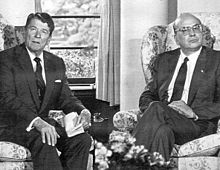
Craxi refused the US request to hand over the hijackers. He insisted that Italy had the right to handle the situation because the crime happened on Italian territory. He allowed one of the hijackers, Abu Abbas, to leave Italy. The other hijackers were later found guilty and sent to prison in Italy. This event showed Craxi's strong stance in international affairs. It earned him praise in Italy, even from his political opponents.
Warning to Libya
Craxi also played a role in the 1986 US air strikes against Libya. According to some sources, Craxi warned Libyan leader Muammar al-Gaddafi about the upcoming attack. This allowed Gaddafi and his family to leave their home before the bombs hit. Italy, along with France and Spain, did not allow US military planes to fly over their airspace for this attack.
Resignation
In April 1987, the Christian Democratic party decided to stop supporting Craxi's government. This led to his government falling. A new government was formed, led by Amintore Fanfani.
After Being Prime Minister
In the 1987 elections, the PSI gained more votes. From 1987 to 1992, the PSI was part of four different governments. They held a strong position, which gave them more power in Parliament. Craxi believed that the fall of communism in Eastern Europe would make the Socialist Party the second largest in Italy. He hoped to lead a new left-wing alliance. However, this did not happen due to new political parties and funding issues.
Challenges and Later Life
A big change in Craxi's career happened in 1992. A Socialist politician was arrested for taking money from a company. This led to investigations into how the party was funded. Craxi argued that many parties used similar ways to get money for their activities. He said that this was part of how politics worked in Italy.
In 1993, Parliament allowed Craxi to be investigated. When he left his hotel, protesters threw coins at him to show their anger. They chanted songs, expressing their disapproval.
In 1994, Craxi left Italy and went to Tunisia. He stayed there, protected by his friend, the Tunisian president Zine El Abidine Ben Ali. He always said he was innocent of personal wrongdoing, but he did not return to Italy. He had been given prison sentences in Italy related to the funding issues.
The investigations into party funding were called Mani pulite (meaning "clean hands"). These investigations affected many politicians in Italy. Some people who supported Craxi felt that his party was unfairly targeted. The Socialist Party's support dropped greatly, and it almost disappeared from politics.
Lifestyle and Public Opinion
Craxi's lifestyle was sometimes criticized. He lived in an expensive hotel in Rome and had a large villa in Tunisia. While many politicians faced issues with party funding, some leaders were seen as living very well. One of his friends was Silvio Berlusconi, who received support for his media companies.
Craxi was known for not apologizing for his actions. He believed he had not done anything different from what others were doing. He felt he was being unfairly singled out.
The End of the PSI
Craxi resigned as party Secretary in February 1993. Between 1992 and 1993, many members left politics. The Socialist Party struggled and almost disappeared in elections. In 1994, what was left of the PSI joined an alliance with the former Communists. However, they only received a small percentage of the votes.
The Italian Socialist Party was officially dissolved on November 13, 1994. It had been a major party for over 100 years. Many of its leaders, including Craxi, were involved in the funding investigations.
Craxism: A Political Idea
Craxism is a term used to describe the political ideas of Bettino Craxi. It was the main way of thinking for the PSI from 1976 to 1994.
What Craxism Meant
Craxism combined ideas from socialism, social democracy, and social liberalism. Under Craxi, the PSI supported helping developing countries and protecting the environment. It also supported the modern welfare state, which provides social services. The party was also pro-American and pro-European. It strongly defended Italy's independence, as seen in the Sigonella incident.
Craxism moved the PSI closer to the political center. This helped the party form alliances with the Christian Democrats and other moderate parties. These alliances created stable governments.
Different Views on Craxism
Today, the term "Craxism" can sometimes be used negatively, linked to the funding issues. However, some people still view Craxi positively. Many who supported him later joined other parties, like Forza Italia led by Silvio Berlusconi.
Craxism, along with the ideas of other European leaders, influenced how socialism changed in Europe during the 1980s. In Italy, former Communists often criticize Craxism. But the current Italian Socialist Party, which includes Craxi's son Bobo Craxi, supports his legacy. Some politicians from the center-right also support his ideas, including his daughter, Stefania Craxi.
Death and Lasting Impact
Bettino Craxi died on January 19, 2000, in Hammamet, Tunisia, at the age of 65. He died from health problems related to diabetes. His family did not accept a state funeral in Italy. They said the government had prevented his return to Italy for medical treatment.
Craxi's funeral was held in Tunisia. Many of his supporters traveled there to say goodbye. Some protesters threw coins at Italian government representatives at the funeral, showing their continued anger. Craxi's grave is in a small Christian cemetery in Hammamet.
Electoral History
| Election | House | Constituency | Party | Votes | Result | |
|---|---|---|---|---|---|---|
| 1968 | Chamber of Deputies | Milan–Pavia | PSI | 23,788 | ||
| 1972 | Chamber of Deputies | Milan–Pavia | PSI | 23,704 | ||
| 1976 | Chamber of Deputies | Milan–Pavia | PSI | 36,992 | ||
| 1979 | Chamber of Deputies | Milan–Pavia | PSI | 65,350 | ||
| 1979 | European Parliament | North-West Italy | PSI | 286,739 | ||
| 1983 | Chamber of Deputies | Naples–Caserta | PSI | 124,833 | ||
| 1987 | Chamber of Deputies | Naples–Caserta | PSI | 165,676 | ||
| 1989 | European Parliament | North-West Italy | PSI | 473,414 | ||
| 1992 | Chamber of Deputies | Milan–Pavia | PSI | 94,226 | ||
See also
 In Spanish: Bettino Craxi para niños
In Spanish: Bettino Craxi para niños





